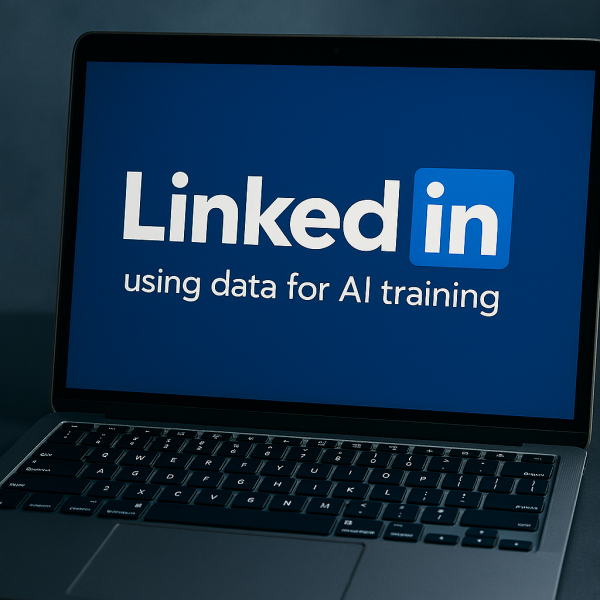What’s Happening
From 3 November 2025, LinkedIn will begin using your profile data, posts, job applications, and interactions to train its generative AI models.
Private messages are excluded, but the collection of data for training is still broad:
- Profile information – name, photo, job history, education, skills, endorsements, and recommendations
- Content creation – posts, articles, poll responses, comments, and contributions
- Job-related data – CVs, answers to screening questions, and application details
- Group activity – what you share and how you interact in LinkedIn Groups
- Feedback data – ratings, reviews, and responses you provide
This applies to users in the UK, EU, EEA, Switzerland, Canada, and Hong Kong.
If you’re a business owner, entrepreneur, or marketing professional who relies on LinkedIn to grow your online presence, it’s important to note that unless you manually opt out, your data will be used for AI training. Any data already collected before opting out will not be removed.
LinkedIn’s updated User Agreement and Privacy Policy suggest that if you don’t opt out, your data could also be used by Microsoft’s affiliates, including Copilot and OpenAI (ChatGPT).
As with any decision, there are pros and cons to weigh before allowing LinkedIn to use your data.
Pros of Letting LinkedIn Use Your Data for AI Training
- Smarter LinkedIn Tools and Insights: AI trained on real content can improve LinkedIn features, offering sharper suggestions, better analytics, and smarter post ideas.
- Productivity Gains through Personalisation: More data means LinkedIn’s AI can create posts, refine profiles, and target audiences with suggestions that feel closer to your voice and goals.
- Early Access to Innovation: Agreeing to share data supports LinkedIn’s product development, meaning you’ll likely enjoy new AI-driven tools sooner.
- Integration with Microsoft AI Tools: Data shared on LinkedIn may improve performance across Microsoft’s AI ecosystem, including Copilot.
- Subtle Influence in Industry Conversations: Your posts and articles could help shape how AI models answer questions in your niche, boosting your invisible thought leadership.
Cons of Letting LinkedIn Use Your Data for AI Training
- Privacy Concerns and Loss of Control: Once your content is used for training, you lose control over where and how it may appear in AI outputs.
- Risk to Competitive Edge: Original strategies and insights you’ve created may surface in AI outputs used by competitors.
- Brand Dilution and No Attribution: AI will not credit you when reusing your style or insights. It’s a shame LinkedIn won’t cite your content, as this would boost transparency and reinforce your thought leadership on the platform.
- Unclear Data Practices: The use of data for AI is enabled by default, and existing content already used cannot be withdrawn. This lack of transparency raises trust issues.
- Legal and Ethical Questions: Automatically opting users in may conflict with GDPR requirements. Ethically, many argue that AI companies benefit from creators’ content without offering credit or reward.
How to Opt Out
Although LinkedIn’s data training doesn’t begin until 3 November 2025, you can opt out now.
Direct link to opt-out setting: LinkedIn AI Data Settings
- Log in to LinkedIn
- Click your profile photo and select Settings & Privacy
- Go to Data Privacy
- Select Data for Generative AI Improvement
- Toggle off “Use my data for training content creation AI models”
- (Optional) Submit LinkedIn’s Data Processing Objection Form to request removal of previously used data (success not guaranteed)
Conclusion & Recommendations
The choice to let LinkedIn use your data for AI training is a balance between innovation and control. The pros offer convenience, efficiency, and early access to tools, while the cons raise concerns about privacy, transparency, and brand ownership.
Recommendation: If you want to stay ahead and are comfortable with some trade-offs, leaving data-sharing enabled could be worthwhile. But share only content you’re happy being repurposed, and avoid posting sensitive or proprietary information. Remember, you can opt out at any time in LinkedIn’s settings.
Now is also a good opportunity to review your LinkedIn Profile and update or remove any personal details you’d prefer not to share. I can help with this in a focused one-hour Teams session.
Next Steps: Get Expert Advice – Not sure how to navigate the intersection of social media and AI for your business? Need help updating your LinkedIn Profile?
Get in touch to discuss how I can support you in making the most of LinkedIn and AI tools like ChatGPT and Copilot while protecting your brand and data.

